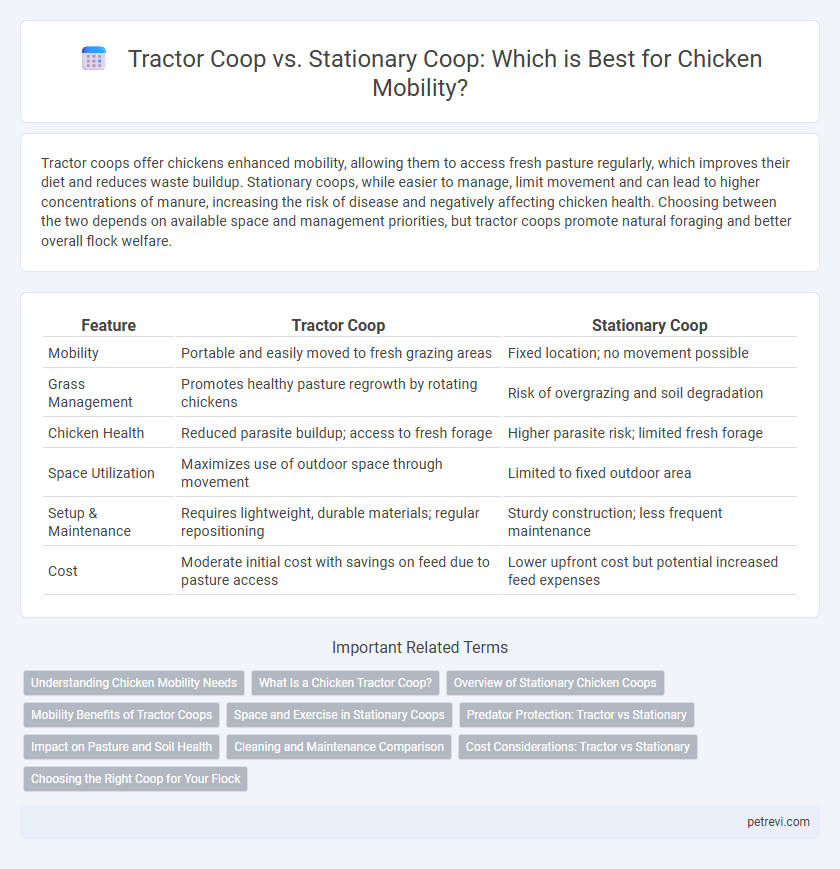Tractor coops offer chickens enhanced mobility, allowing them to access fresh pasture regularly, which improves their diet and reduces waste buildup. Stationary coops, while easier to manage, limit movement and can lead to higher concentrations of manure, increasing the risk of disease and negatively affecting chicken health. Choosing between the two depends on available space and management priorities, but tractor coops promote natural foraging and better overall flock welfare.
Table of Comparison
| Feature | Tractor Coop | Stationary Coop |
|---|---|---|
| Mobility | Portable and easily moved to fresh grazing areas | Fixed location; no movement possible |
| Grass Management | Promotes healthy pasture regrowth by rotating chickens | Risk of overgrazing and soil degradation |
| Chicken Health | Reduced parasite buildup; access to fresh forage | Higher parasite risk; limited fresh forage |
| Space Utilization | Maximizes use of outdoor space through movement | Limited to fixed outdoor area |
| Setup & Maintenance | Requires lightweight, durable materials; regular repositioning | Sturdy construction; less frequent maintenance |
| Cost | Moderate initial cost with savings on feed due to pasture access | Lower upfront cost but potential increased feed expenses |
Understanding Chicken Mobility Needs
Understanding chicken mobility needs is crucial when choosing between a tractor coop and a stationary coop. Tractor coops provide daily access to fresh pasture, promoting natural foraging behavior and enhancing chicken health through increased exercise. Stationary coops offer stability and protection but limit chickens' movement and the benefits of varied diet found in rotational grazing systems.
What Is a Chicken Tractor Coop?
A chicken tractor coop is a movable enclosure designed to provide chickens with fresh pasture while protecting them from predators. Unlike stationary coops, it allows chickens to naturally forage and promotes healthier soil by evenly distributing manure. This mobility supports better chicken welfare and sustainable backyard farming practices.
Overview of Stationary Chicken Coops
Stationary chicken coops provide a fixed, secure shelter that offers consistent protection against predators and harsh weather conditions, making them ideal for long-term poultry housing. These coops typically feature durable materials, enhanced ventilation systems, and nesting boxes designed to optimize egg production and hen comfort. While stationary coops limit chicken mobility compared to tractor coops, their stability supports efficient maintenance and biosecurity management in backyard or commercial settings.
Mobility Benefits of Tractor Coops
Tractor coops offer superior mobility benefits for chicken farming by allowing easy relocation to fresh pasture, which promotes healthier foraging and natural pest control. This movement helps reduce soil compaction and prevents nutrient buildup, enhancing land sustainability and improving flock health. In contrast, stationary coops limit chickens to a fixed area, increasing the risk of overgrazing and disease accumulation.
Space and Exercise in Stationary Coops
Stationary coops limit chickens' movement due to confined space, reducing their opportunity for exercise and natural behaviors. Unlike tractor coops that allow rotation and access to fresh pasture, stationary coops often result in overcrowding and less physical activity. Optimizing space within stationary coops is essential to improve chicken welfare and prevent health issues related to inactivity.
Predator Protection: Tractor vs Stationary
A tractor coop offers enhanced predator protection through constant movement, reducing the likelihood of predators establishing a presence near the flock, while stationary coops can become vulnerable to repeated attacks if located in a predator-prone area. Tractor coops often feature reinforced wheels and secure latching mechanisms, providing both mobility and safety, whereas stationary coops must rely heavily on robust structural defenses like hardware cloth and elevated designs to deter predators. The dynamic nature of tractor coops not only limits predator access but also promotes healthier conditions by preventing the buildup of waste and scent trails that attract predators.
Impact on Pasture and Soil Health
Tractor coops promote chicken mobility by allowing regular relocation, which enhances pasture regeneration and prevents soil compaction. Stationary coops often lead to over-concentration of chickens in one area, causing soil degradation and nutrient imbalances that harm grass growth. Mobile systems support healthier soil microbiomes and improve pasture sustainability through controlled grazing patterns.
Cleaning and Maintenance Comparison
Tractor coops offer superior cleaning and maintenance advantages due to their mobility, allowing frequent relocation that reduces waste buildup and minimizes ammonia levels, promoting healthier chicken environments. Stationary coops require more intensive cleaning routines to manage accumulated droppings and prevent disease but often feature more robust structural elements that may simplify routine maintenance tasks. Optimizing coop hygiene with tractor coops can lead to decreased mortality rates and improved overall flock health through enhanced sanitation practices.
Cost Considerations: Tractor vs Stationary
Tractor coops typically demand higher initial investment due to materials and mobility mechanisms but offer cost savings over time by enabling pasture rotation, reducing feed and parasite control expenses. Stationary coops entail lower upfront costs but incur ongoing expenses related to litter management, soil degradation, and limited natural foraging opportunities for chickens. Evaluating the total cost of ownership highlights that tractor coops often provide better long-term economic efficiency despite their higher starting price.
Choosing the Right Coop for Your Flock
Tractor coops offer enhanced mobility, allowing chickens to access fresh pasture daily, which improves diet variety and reduces parasite buildup. Stationary coops provide a stable, secure environment with consistent shelter but require manual cleaning and waste management. Choosing the right coop depends on flock size, available space, and desired grazing benefits versus maintenance effort.
Tractor Coop vs Stationary Coop for Chicken Mobility Infographic

 petrevi.com
petrevi.com